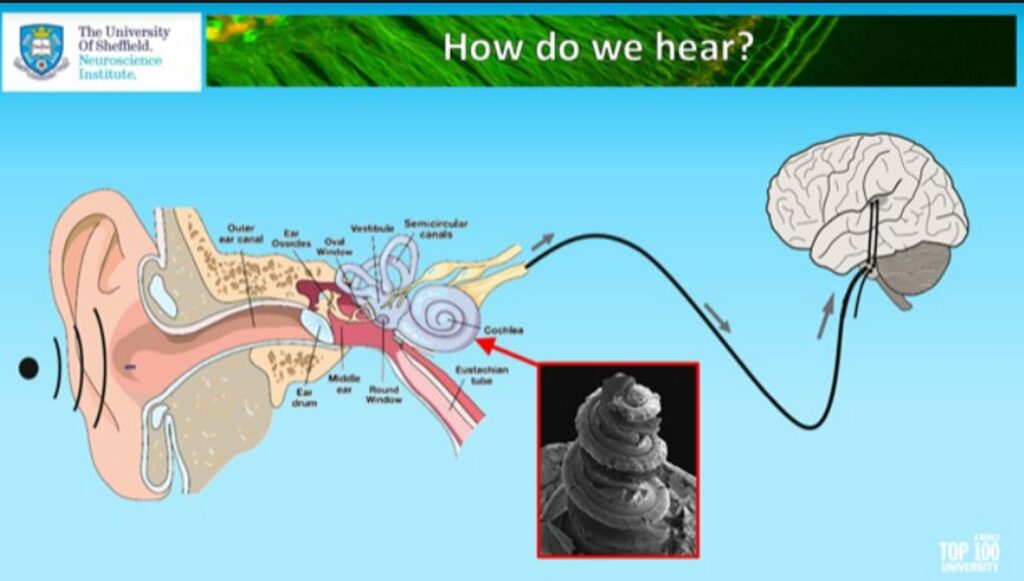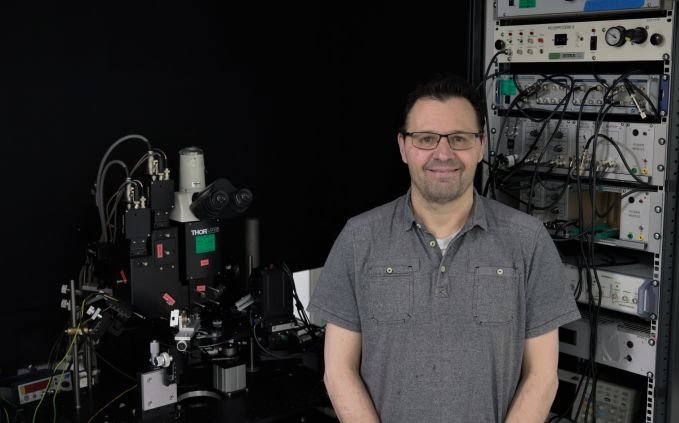Prof Marcotti, Professor of Sensory Neuroscience at the University of Sheffield, began his talk by showing how we hear by putting on screen a diagram of the ear. He explained that the cochlea shown in the diagram is a spiral-shaped bone structure found in the inner ear that contains the hearing organ. This organ plays a key role in the sense of hearing and participates in the process of auditory transduction. Sound waves are transduced into electrical impulses that the brain can interpret as individual frequencies of sound. He emphasised that the brain cannot directly understand the various senses including hearing, light, taste and smell.
Our two ears act independently of one another so that when there is a sound on a person’s right hand side their right ear will pick this up microseconds before their left one does. Hair cells in the cochlea are the devices which send messages to the brain. Walter explained how the cochlea works rather like a piano moving from a low pitch to a high pitch which he demonstrated with a diagram resembling a piano keyboard.
He went on to explain how deafness occurs, describing it as the most common sensory disorder in human beings as well as being a contributory factor in the progression of dementia. He explained how people can be affected at any age and there was a potential problem with younger people having their hearing impaired by listening constantly to mobile devices held close to their ear. In fact, it has been estimated by the World Health Organisation that, by the year 2050, a quarter of the world’s population – namely 2.5 billion people – will be suffering from some form of hearing loss and about 700 million will be in need of treatment for it.
When hair cells or their neuronal fibres connecting them to the brain become damaged they cease to function effectively in the transmission of messages to the brain thereby causing partial or full deafness.
He explained that two genes had been identified which lead to age related loss of hearing and experiments were taking place with mice under strict animal safety regulations. These were taking the form of injecting good genes, by making a small horizontal incision under sedation, into the animal’s ear. Results were at an early stage of development in delivering good genes to damaged hair cells.
Walter, who graduated with a degree in biological science at the University of Pavia in Italy in 1992, explained that he has working under him at the Gene-based Therapy Suite for Hearing Loss at the university a fully staffed research group. They are carefully chosen and are very bright people who are drawn from many different countries and age groups. He also highlighted that The Dudley and Geoffrey Cox Charitable Trust provided the funding to establish the therapy suite at Sheffield, but as with all research much more money is needed to enable he and his team to function to full potential. This will enable them to carry out the further research work required to make real inroads into what is a universal problem.
Walter finished his talk by stating that such research work was long overdue but at least it was now ongoing. A comment was made from the floor that it was incredible how the genius that was Beethoven was able to compose symphonies when he had become totally deaf. He clearly had a retentive memory for the sound of every key on a piano keyboard.


